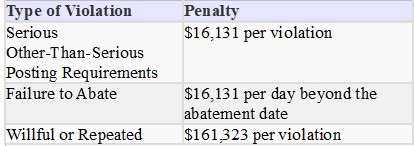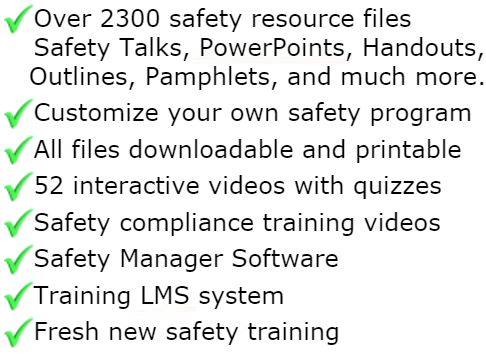
Heat Stress & Heat Stroke
Certain safety problems are common to hot environments. Heat tends to promote accidents due to heat stress, heat stroke, slipperiness of sweaty palms, dizziness, or the fogging of safety glasses.
Workers at risk of heat stress include outdoor workers and workers in hot environments such as firefighters, bakery workers, farmers, construction workers, miners, boiler room workers, factory workers, and others. Workers at greater risk of heat stress include those who are 65 years of age or older, are overweight, have heart disease or high blood pressure, or take medications that may be affected by extreme heat resulting in heat stress.
Prevention of heat stress in workers is important. Employers should provide training to workers so they understand what heat stress is, how it affects their health and safety, and how it can be prevented.
Heat Stroke
Heat stroke is the most serious of health problems associated with working in hot environments. It occurs when the body's temperature regulatory system fails and sweating becomes inadequate. The body's only effective means of removing excess heat is compromised with little warning to the victim that a crisis stage has been reached.
A heat stroke victim's skin is hot, usually dry, red or spotted. Body temperature is usually 105_F or higher, and the victim is mentally confused, delirious, perhaps in convulsions, or unconscious. Unless the victim receives quick and appropriate treatment, death can occur.
Any person with signs or symptoms of heat stroke requires immediate hospitalization. However, first aid should be immediately administered. This includes removing the victim to a cool area, thoroughly soaking the clothing with water, and vigorously fanning the body to increase cooling. Further treatment at a medical facility should be directed to the continuation of the cooling process and the monitoring of complications which often accompany the heat stroke. Early recognition and treatment of heat stroke are the only means of preventing permanent brain damage or death.
Heat Cramps
Heat cramps are painful spasms of the muscles that occur among those who sweat profusely in heat, drink large quantities of water, but do not adequately replace the body's salt loss. The drinking of large quantities of water tends to dilute the body's fluids, while the body continues to lose salt. Shortly thereafter, the low salt level in the muscles causes painful cramps. The affected muscles may be part of the arms, legs, or abdomen, but tired muscles (those used in performing the work) are usually the ones most susceptible to cramps. Cramps may occur during or after work hours and may be relived by taking salted liquids by mouth.
Fainting
A worker who is not accustomed to hot environments and who stands erect and immobile in the heat may faint. With enlarged blood vessels in the skin and in the lower part of the body due to the body's attempts to control internal temperature, blood may pool there rather than return to the heart to be pumped to the brain. Upon lying down, the worker should soon recover. By moving around, and thereby preventing blood from pooling, the patient can prevent further fainting. Heat Rash Heat rash, also known as prickly heat, is likely to occur in hot, humid environments where sweat is not easily removed from the surface of the skin by evaporation and the skin remains wet most of the time. The sweat ducts become plugged, and a skin rash soon appears. When the rash is extensive or when it is complicated by infection, prickly heat can be very uncomfortable and may reduce a worker's performance. The worker can prevent this condition by resting in a cool place part of each day and by regularly bathing and drying the skin.
Transient Heat Fatigue
Transient heat fatigue refers to the temporary state of discomfort and mental or psychological strain arising from prolonged heat exposure. Workers unaccustomed to the heat are particularly susceptible and can suffer, to varying degrees, a decline in task performance, coordination, alertness, and vigilance. The severity of transient heat fatigue will be lessened by a period of gradual adjustment to the hot environment (heat acclimatization).
Heat Exhaustion
Heat exhaustion includes several clinical disorders having symptoms which may resemble the early symptoms of heat stroke. Heat exhaustion is caused by the loss of large amounts of fluid by sweating, sometimes with excessive loss of salt. A worker suffering from heat exhaustion still sweats but experiences extreme weakness or fatigue, giddiness, nausea, or headache. In more serious cases, the victim may vomit or lose consciousness. The skin is clammy and moist, the complexion is pale or flushed, and the body temperature is normal or only slightly elevated..
In most cases, treatment involves having the victim rest in a cool place and drink plenty of liquids. Victims with mild cases of heat exhaustion usually recover spontaneously with this treatment. Those with severe cases may require extended care for several days. There are no known permanent effects.
All materials in the members area for this topic index

GET INSTANT ACCESS
to THE MEMBERS LIBRARY
Safety materials created by safety professionals.
Access to the Safety Manager software.
Wide variety of safety videos and courses.
**Brand New** Safety Training Management System
Pre-Made Safety Materials Ready For Use
Created by experienced safety professionals & risk consultants. Saving you time, money, and risk of injuries.
95% of the work already done.
Below are the maximum penalty amounts, with the annual adjustment for inflation, that may be assessed after Jan. 15, 2024. (See OSHA Memo, Jan. 8, 2024).

**New OSHA HEAT 90 DAY**
>>Download Free HERE<<
**New 2024 OSHA 300 Form**
>>Download Free HERE<<
**Brand New**
Free with full membership subscription
Training LMS System
Ask The Safety Consultant
Safety Equipment Deal Finder

“SafetyInfo.com is the first go-to website for safety professionals and companies to use in establishing a solid safety program"
-Mike McKenzie, Certified Safety & Health Manager (CSHM), McSafety Solutions™
Note: You must have a full subscription to the Safety Library in order to use this material. Any use outside of your organization, for resell, or without an active membership is strictly prohibited and may result in prosecution under copyright infringement laws. Please contact us first, if you would be interested in reselling or using our materials for reproduction.
Inside the Members Library
Topic Index
Accident Prevention
Air Quality
Asbestos
Bloodborne Pathogens
Boilers
Chemical Safety
Compressed Gas
Confined Space
Construction
Construction Worksite
Cranes & Slings
Driver / Fleet Safety
Drug Free Workplace
Electrical
Emergency Management
Engineering Safety
Environmental
Equipment
Ergonomics
Fall Protection
Fire Safety & Prevention
First Aid
Flammable Materials
Forklifts
Hazard Communication
Hazardous Materials
Hearing Protection
Heat Stress
Hot Work
Housekeeping
Job Safety Analysis
Laboratory
Ladders
Lead
Lockout-Tagout
Machinery & Equipment
Material Handling
MSDS (SDS)
Medical & First Aid
Occupational Health
Office Safety
Off the Job Safety
Personal Protection
Process Safety
Record Keeping
Respiratory Protection
Silica Safety
Rules & Policies
Signs & Labels
Slips, Trips & Fall
Training
Terrorism Programs
Tool Safety
Vehicle & Driver
Violence Programs
Welding & Hot Work
Training Videos
Library Index
Training Materials
Videos/Courses
Talks
Articles
PowerPoint
Handouts
Training Overheads
Quizzes
Supervisor Briefs
Management Briefs
Safety Sessions
2 Minute OSHA Safety Talks
Pamphlets
First Aid Training
Supervisor Training
Hazardous Materials
Bomb Threat
Crossword Puzzles
Biological Agents
Forms & Documents
Forms
Checklists
Audit Guides
Inspections Guides
Signs & Labels
Environmental Audit Guides
Recordkeeping - OSHA 300
Sign & Label Maker
Safety Management Resources
Safety Manuals/Written Programs
Ergonomic Programs
Emergency Plans
Process Safety Management
Construction Safety
Occupational Health
Environmental
Topic Sheets
DOT Fleet-Driver
Hazardous Materials
Chemical Safety
Drug Free Workplace
Terrorism Programs
Development Guides
Safety Manager Software
Safety References & Graphics
Technical Safety Information
Posters
Topic & Fact Sheets
Development Information
Job Specific Safety Rules
Terrorism
Calculators
Safety Comic Strips
New Safety Training System
Schedule and train your employees with our materials. Add unlimited amount of employees. Record all progress and issue certificates. For group and individual training sessions.

